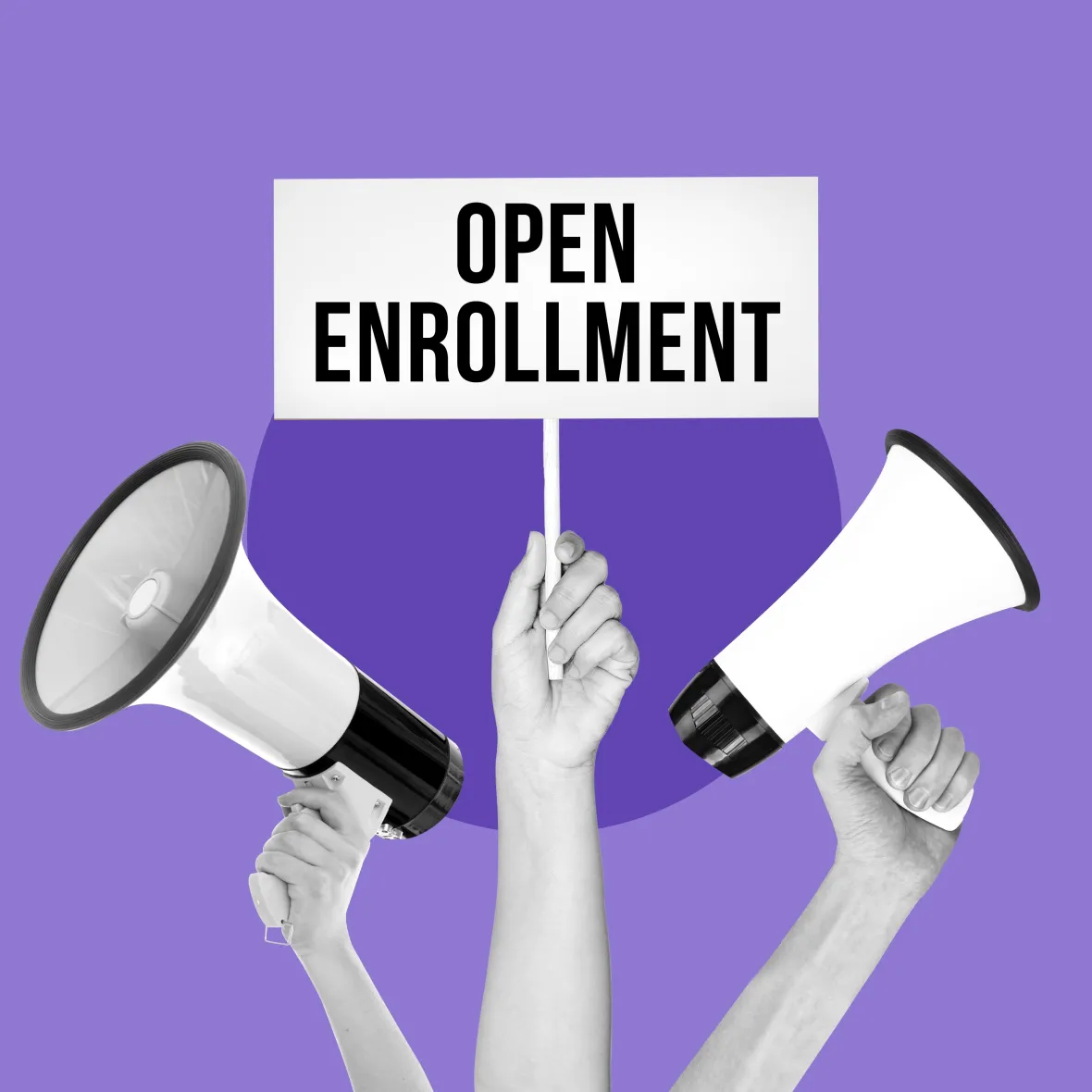How to Help Prepare Employees for Benefits Enrollment: A Step-by-Step Guide for HR

Selecting the optimal benefits coverage can be a stressful and even overwhelming task for your employees. Yet, as health care costs continue rising, it’s more important than ever for coverage to align with their needs. The 2025 State of Employee Benefits report revealed that prescription costs were up 38% over the last two years, along with a 17% increase in chronic condition claims. On top of this, a Voya Financial Consumer Insights & Research survey found that 79% of millennials1 —who make up the largest proportion of the workforce—say financial stress impacts their mental health. These numbers highlight a persistent HR challenge: despite the available comprehensive benefits packages, employees may struggle with enrollment decisions.
This open enrollment (OE) season brings unique pressures and opportunities. Elevated stress demands more support and clearer guidance, which invites employers to demonstrate care through thoughtful tools, processes, and resources. This guide for benefits leaders covers strategic preparation, communication tactics and practical tools intended to streamline your enrollment process while ensuring employees can confidently select the appropriate coverage for their needs.
Planning Your Benefits Enrollment Timeline
Successful open enrollment begins with careful planning, starting 6-8 weeks before your enrollment period kicks off.
- Create a master timeline. Use this to map critical milestones such as vendor deadlines, system testing, employee communications and enrollment cutoffs. This prevents last-minute scrambles that plague many enrollment periods.
- Assemble a cross-functional team. This typically includes HR, IT, Finance and Communications. Define clear roles and establish weekly check-ins to maintain momentum and catch issues early.
- Audit last year’s data. Before planning this year's OE process, review some key data around participation rates by benefit type and department. Also, identify questions that dominated your help desk. This analysis can help reveal pain points that require targeted solutions through improved communication or simplified workflows.
Optimizing Communication Strategy
Once your timeline and teams are defined, you can work on your communication strategy to bring it to frame the enrollment experience.
- Develop multi-channel communication. Consider how different employee groups consume information. Email and virtual events may work for desk-based employees, but bulletin boards or mobile resources may be better for reaching manufacturing or other frontline workers.
- Create comparison charts that eliminate jargon and focus on real scenarios. Employees need to understand what happens when they visit the doctor, not insurance terminology. Videos work well for explaining complex topics like health savings accounts (HSAs) and retirement planning.
- Launch awareness campaigns 4-6 weeks before enrollment. Intensify communications two weeks prior and throughout enrollment, then end with urgent deadline reminders. Accommodate different learning preferences –infographics for visual learners, webinars for auditory learners, hands-on workshops for kinesthetic learners and detailed guides for independent researchers.
- Provide continuous employee support. Throughout your enrollment period, make it easy for employees to get support when they need it. In addition to educational materials, consider standing up a dedicated email address for questions, a phone hotline, and/or drop-in hours for 1:1 consultations.
Related reading: 10 Simple Ways to Improve Employee Communication about Benefits
Streamlining the Enrollment Process
Creating an OE experience that is easy and convenient for employees can potentially boost participation, while also relieving your team of some of the administrative burden.
- Assess your enrollment platform's user experience. Evaluate components such as navigation clarity, mobile responsiveness and performance during peak periods. Slow systems create frustration that can affect benefit satisfaction year-round.
- Prioritize integration capabilities over flashy features. Your system should connect seamlessly with HR systems, payroll platforms and vendor databases to minimize errors and administrative overhead.
- Partner with IT early to test system capacity and verify security protocols. Prepare backup plans for potential outages—technical difficulties during enrollment may undermine employee confidence. Train your help desk specifically for enrollment issues and create self-service troubleshooting guides.
Supporting Employee Decision-Making
Helping employees make benefit selections that align with their health needs and goals creates prime conditions for future benefits engagement.
- Help employees understand costs. Provide benefits calculators and cost comparison worksheets for specific employee circumstances. Develop scenarios reflecting your population – single versus family coverage, high-deductible versus traditional plans and annual financial impact.
- Engage employees with interactive tools. Needs assessment questionnaires can help guide employees toward appropriate selections by asking about medical needs, family planning and risk tolerance. Interactive tools can be effective with complex choices like retirement contributions.
- Provide customized support. Offer one-on-one counseling for employees facing life changes or previous enrollment difficulties. Provide information sessions specific to different life stages—younger employees may focus on basic coverage while pre-retirees need retirement transition information.
- Simplify the benefits landscape. Create educational content that builds benefits literacy, including glossaries for terminology and scenario-based examples demonstrating real-world plan differences.
- Use a dedicated tool. Leverage benefits technology, like Decision Support, to make all of this simple and personalized for optimized guidance
Related reading: How to Boost Employees’ Personal Health Literacy
Managing the Enrollment Period
Don’t wait until enrollment ends to monitor the process—being proactive can help keep you on target for your participation goals while giving you the opportunity to reveal and resolve friction points along the way.
- Monitor participation daily. Review participation by department and benefit type to identify areas needing support. Track help desk issues and adjust communications accordingly. Address enrollment obstacles. Some departments may show lower participation due to unavoidable circumstances like work schedules or access limitations. Provide targeted outreach through managers, alternative communication channels or extended access.
- Maintain clear deadline communication. Describe specific consequences of missing enrollment, including waiting periods and coverage gaps.
Post-Enrollment Follow-Up
Verify enrollment data immediately to prevent payroll errors and coverage gaps. Follow up on incomplete enrollments before implementing deductions. To boost visibility with other organizational leaders, generate reports that document OE outcomes and improvement areas.
Gather feedback through post-enrollment surveys and team debriefs. Capturing the lessons learned while insights are fresh will give you a leg up for next year’s planning.
Frequently Asked Questions
How can HR help to improve employee participation in benefits enrollment?
Focus on early communication, multiple touchpoints and personalized guidance. Use data from previous years to identify departments or demographics with low participation and create targeted outreach strategies. Offer tools like Decision Support to provide personalized guidance during the enrollment process.
What's the optimal way to communicate benefits options to employees?
Implement a multi-channel approach that includes email, intranet, meetings and print materials. Use clear, jargon-free language and provide visual aids like comparison charts and decision trees.
What should HR include in a benefits enrollment checklist?
Essential items include timeline creation, stakeholder coordination, communication planning, technology testing, support resource preparation and post-enrollment follow-up procedures.
How early should benefits enrollment preparation begin?
Our experience indicates you will want to start planning 6-8 weeks before the enrollment period begins. This allows time for material creation, system testing, communication development and team coordination.
What are the most common benefits enrollment mistakes to avoid?
Missteps can include inadequate communication timing, complex or confusing materials, insufficient technical support, lack of decision-making tools and poor follow-up on incomplete enrollments.
Your open enrollment period is just one small piece of the benefits experience for your employees. To help them get the most out of the coverage they select, year-round communication is crucial. Read our Employee Communications Strategy ebook to learn more about boosting benefits engagement and supporting better health outcomes for your employees and their families.
Download our eBook


